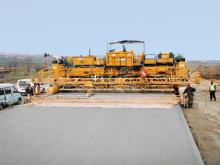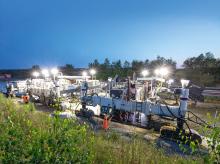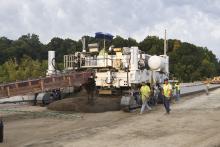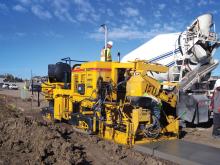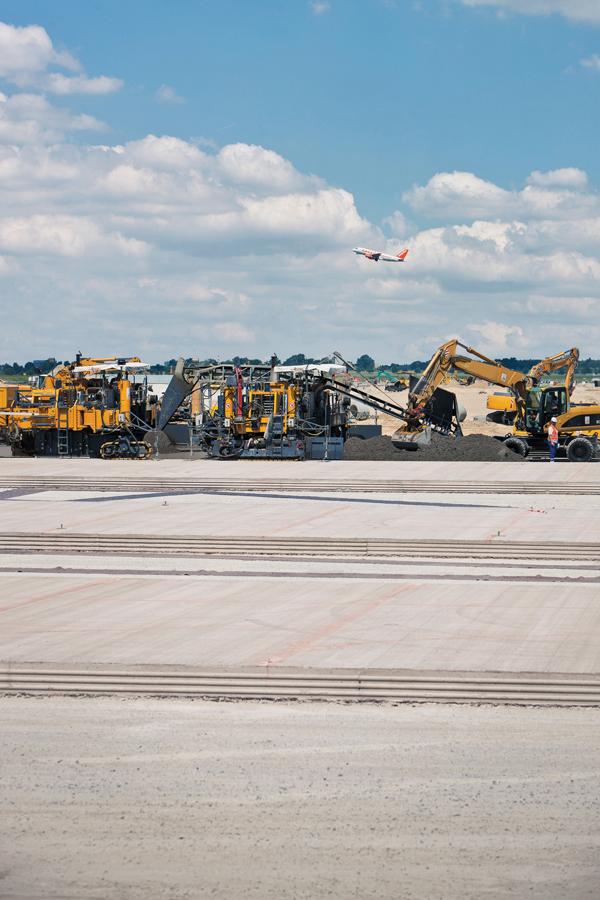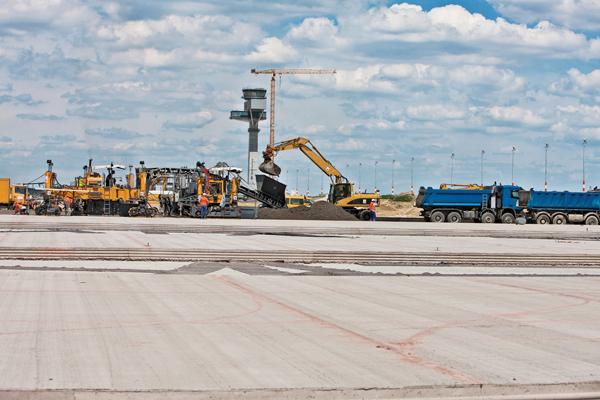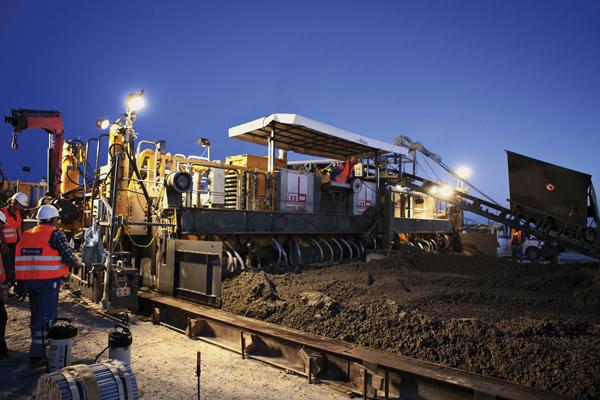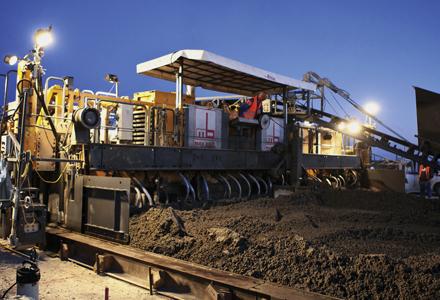The Silk Route is one of the oldest trading links between Europe and Asia and is being upgraded with some of the newest equipment. The nation of Georgia is located on what is known as the ‘crossroads’ between Western Asia and Eastern Europe. It lies to the east of the Black Sea and is on one of the shortest routes between western China and Europe. Since the Middle Ages this strategically important country has played host to one of the network of roads collectively known as the Silk Route. For much of the 20
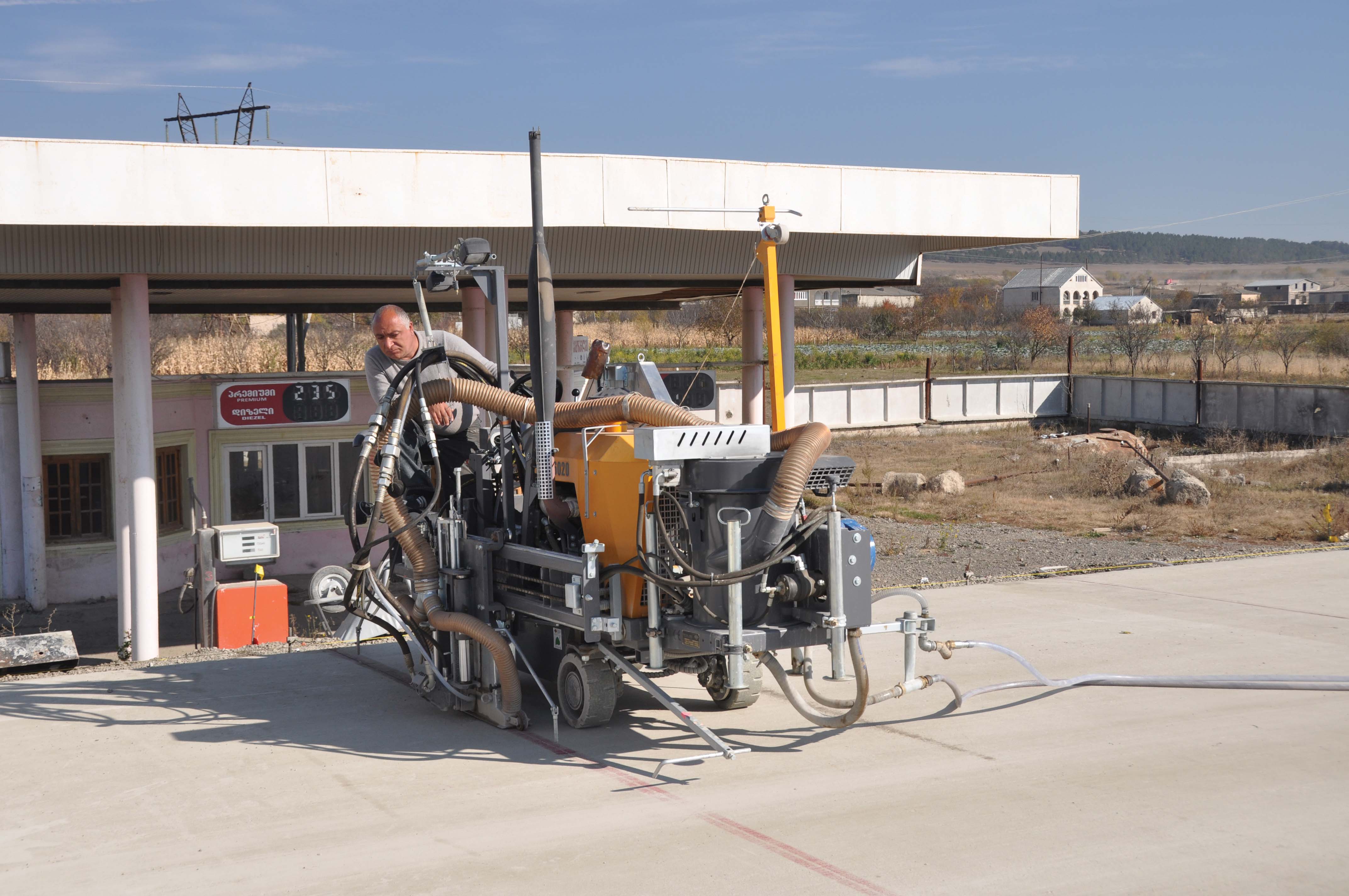
Sawcutting of the surface is carried out above the embedded dowels
The Silk Route is one of the oldest trading links between Europe and Asia and is being upgraded with some of the newest equipment
The nation of Georgia is located on what is known as the ‘crossroads’ between Western Asia and Eastern Europe. It lies to the east of the Black Sea and is on one of the shortest routes between western China and Europe. Since the Middle Ages this strategically important country has played host to one of the network of roads collectively known as the Silk Route. For much of the 20th century Georgia was under Soviet rule and its infrastructure remained very underdeveloped by Western standards. In 1991 it became an independent nation but by the year 2000 the country’s GDP had dropped to 30 – 35% of its 1990 level and in 2003 the Rose Revolution saw Georgia become a democracy. Five years later, in 2008, hostilities broke out with the former colonial power Russia which led to further collateral damage to Georgia's already underdeveloped infrastructure.
After the hostilities ended, the government of Georgia made development of the country’s transport infrastructure a priority and in 2006 requested assistance from the2332 World Bank and the International Bank of Reconstruction and Development to help modernise its East-West transport corridor. This road which once formed part of the old Silk Route remains internationally important because it still forms part of a corridor connecting Europe with Asia without needing to enter either Russia to the north or Iran in the south. Today Georgia's East-West transport corridor forms part of the pan-European E60 route which runs from the Atlantic Coast in France to Irkeshtam in Kyrgyzstan on the border with People's Republic of China.
The section of the E60 within Georgia runs almost 400km from the Red Bridge at the Azerbaijan Border to the Black Sea port of Poti and consists of two lanes of narrow (often only 7m wide without shoulders) and winding roads. It represents around a quarter of Georgia’s international road network and accounts for half of the country’s international journeys. Average traffic is around 7,800 vehicles per day of which 69% are cars, 19% are pickups or minibuses with buses and medium trucks accounting for another 6% and heavy or articulated trucks making up the remainder.
Outside of the Georgian Capital, Tbilisi, the existing road follows the old route which connected one town and village to the next and therefore all traffic goes through each settlement, making for long transit times and heightening the risk of accidents. Progress has been made in that from a peak of 16.8 road deaths/100,000 inhabitants in 2009 Georgia’s fatality rate has dropped back to 11.7 deaths/100,000 inhabitants in 2011. Even at that level the fatality rate remains significantly worse than the3287 EU countries and means there is scope for further improvement.
Under the plan approved by the World Bank the road is being upgraded to a new four lane concrete highway and while some resettlement is required along the route, the new road is designed to bypass most settlements. When it is completed the new road will allow quick and safe movement of people and goods between the Black Sea ports and the borders with Armenia and Azerbaijan. Additional funding will help finance the rehabilitation of about 450km of priority secondary and local roads throughout the country that are currently in poor condition.
Back in 2006 when the first contracts were being awarded, Georgia’s domestic contractors did not have the experience of building road to the required standard. This has resulted in a number of international contractors from Germany, Israel and beyond constructing various sections of the road. While the E60 project is advancing well with only around 100km of roadway yet to be contracted, it will be 2020 before it is finished because the remaining sections run through the mountains and will involve bridge and tunnel building. Additional financing was required for the upgrading of the existing Rikoti Tunnel (143km west of Tbilisi) and some repairs have also been required on newly laid sections of the road.
3260 World Highways visited one of the latest sections under construction, a 19km stretch some 95km to the west of Tbilisi where the two-lane asphalt road is being upgraded to four lanes. The initial part of the section follows the old route and is being constructed alongside the existing carriageways but the new road detours round a small village rather than passing through. Within the19km section are five intersections and with two lanes Plus a hard shoulder the carriageway width is 11.5m and extends to 12.25m for the lead-off and lead-on ramps. Some vertical realignment is required although generally it crosses reasonably flat terrain.
Chinese contractor China Nuclear won the contract to build and rebuild this section of the road and has combined its own 86-strong management team with local workers to operate the machinery on site.
The road is being constructed as two concrete layers In order to utilise locally available aggregates. A 21cm thick lower layer contains locally produced round river aggregates and river washed 'brown sand' while the 7cm upper layer uses higher quality crushed aggregates. Both the top and bottom mix concrete is prepared at a nearby batching plant which is run by2551 HeidelbergCement.
The road is one of the first to be built using225 Guntert & Zimmerman’s (G&Z) latest S850SL slipform paver. According to G&Z president Ron Meskis, “This particular arrangement uses two S850SL slipform pavers one behind the other and both have been modified for this job. The front paver finishes the bottom slab and is equipped with both dowel bar and tie-bar inserters to position the bars at the required depth. A concrete pass-over transfer belt is also fitted to the first machine to feed the top-mix material to the second S850SL paver following immediately behind.”
Fitted to the second S850SL are vibrators with adjustable vibrating force and these are set to consolidate the material without disturbing the dowels and tie-bars inserted into the bottom layer moments earlier by the lead machine. To produce the required surface finish, the second machine is equipped with a heavy-duty oscillating beam and is followed by a final finisher. Following the paving train is G&Z's Texture & Cure TC1500 fitted with burlap to texture the surface and to apply the curing compound.
Two-machine arrangements are around a third more expensive than the more common configuration of a single lift machine with a pass-over conveyor and additional framework to carry a second paving kit to add the top layer. However, mobility considerations led the contractor to settle on this configuration because it is easier to transport (and possibly sell) two relatively small and flexible machines than one very large specialist piece of equipment which has to be dismantled for each move.
The SL designation in the S850SL’s model name denotes that the paver is equipped with swing legs. In this particular project the swing legs facility allows the contractor to change the configuration in minutes and widen the tractor from the 11.5m for the main carriageway to 12.25m by swinging the legs and tracks outwards on one side. This feature is one of the major enhancements over G&Z’s original S850 model (the S850Q) where the legs are attached to the machine by a telescoping end bolster and limit the maximum paving width to 10.25m.
China Nuclear also specified the machines with G&Z’s telescopic end sections which allow rapid width change of up to 1.25m per side. In combination with the swing leg feature, this enables the contractor to quickly change (in less than 30 minutes) from the 11.5m width of the main carriageway to the 12.25m specified for the lead-on and lead-off ramp sections.
These features make it possible to avoid stopping the paving process at each off- and on-ramp to modify the width of the paver tractor and paving kit before starting again. Meskis said this can save between a half and a full shift each time the width needs to be altered.
Following immediately behind the rear paver is a G&Z TC1500 texture cure machine which adds curing compound to the surface of the slab. This slows the drying process and gives the mix time to build up enough strength to ward off any stresses caused by the shrinkage of the concrete in the drying process. The chances of concrete cracking reduce significantly if proper curing procedures are followed, added Meskis.
As technical support may not be as quickly to hand in Georgia as it is in G&Z’s native US, the lead machine is one of the first to be fitted with the company’s new Equipment Guidance and Operation Network (EGON) system.
EGON interfaces with the standard engine diagnostics, monitoring and CAN Bus systems to monitor almost all of the machine’s instrumented electrical and hydraulic parameters. That data can then be transmitted from machines anywhere in the world back to G&Z’s headquarters in America using either Wi-Fi or GSM connectivity.
Should the onboard systems detect a fault EGON will automatically send an email alert to both the user and G&Z. Meskis said, “Very often we will know about a problem or an impending problem before it comes to the attention of the operator on site. If a problem does arise, our technicians can look at the transmitted information and advise the people on site what the trouble is, where it is located and how they can fix it.”
He added, “In many instances our technicians can advise those on site to make adjustments, change a filter or faulty component thereby preventing the situation from deteriorating to a point where production will be interrupted. And in the worst case if an engineer has to be sent out they will arrive at the site knowing what the problem is and will have come equipped with the tools and spares to do a fast single-visit repair.”
The EGON unit is fitted on-line and shipped with its modem only requiring the appropriate SIM card to be inserted to complete the connection.
Diagnostics aside, this combination of machinery means an 11.5m wide two-layer road, with different mixes complete with longitudinal and transverse dowels, can be paved in a single pass. The ability to use different material specification for each layer is being fully exploited to minimise cost and utilise local produce by including ‘brown sand’ and different aggregates in the mix. Unfortunately, the local brown sand mix does not perform as well in areas like the road edges.
To overcome this, several mixes have been tried on a test area but the results have still not been to specification so the brown sand is only being used on the lower layer with yellow sand used for the top.
Theoretical paving speeds on the S850SL can easily surpass one metre/minute which in this case would require some 200m3 of concrete/hour with a 3:1 split between the lower and upper layer specification materials. The concrete is produced by two twin twin-shaft mobile batching plants: a Meka MB-135BM and a Euromix 140 which have both been modified for this project by increasing the capacity beyond that of the standard product.
In Meka’s case the maximum capacity from its MB-120BM mobile plant is 120m3/hr while the modified MB-135BM in Georgia has had its maximum output boosted to 135m3/hr. This modification is designed to enable it to achieve 120 m3/hr (with 45 sec mixing time) of the S1 low slump concrete specified for this job. Equally the Euromix 140 can produce 140m3/hr, again up from the120m3/hr of the company's top listed standard product.
With a combined capacity of 275m3/hr these batching plants have ample capacity. “In planning for how much concrete we need in front of the paver to sustain a certain production, we usually figure on 75% of the peak capacity as being the sustainable production rate and that’s not usually far off,” Meskis said.
However, the need to use yellow sand in the top layer has reduced production flexibility as the Meka has only been equipped with four aggregate bins, while with six bins the Euromix can swap between yellow and brown sand.
In the section World Highways visited, the first two lanes were being added adjacent to the existing road but will bypass settlements that the existing road intersect. In the particular section under construction during our visit the new roadway was being laid some 1.25m above the level of the existing adjacent road while further on in the section the two are at the same level.
Infrastructure such as culverts and bridges are being installed in preparation for the new road with prefabricated sections being used on bridge spans to minimise disruption of traffic on the existing road.
The materials considerations and other difficulties had prevented China Nuclear from being able to use the pavers to their full capacity before the winter weather brought a seasonal halt to road construction. When the snow melts production can begin again at full speed and, having been around for 2,000 years, a short delay is but a bat of an eyelid in the history of the Silk Route.
The nation of Georgia is located on what is known as the ‘crossroads’ between Western Asia and Eastern Europe. It lies to the east of the Black Sea and is on one of the shortest routes between western China and Europe. Since the Middle Ages this strategically important country has played host to one of the network of roads collectively known as the Silk Route. For much of the 20th century Georgia was under Soviet rule and its infrastructure remained very underdeveloped by Western standards. In 1991 it became an independent nation but by the year 2000 the country’s GDP had dropped to 30 – 35% of its 1990 level and in 2003 the Rose Revolution saw Georgia become a democracy. Five years later, in 2008, hostilities broke out with the former colonial power Russia which led to further collateral damage to Georgia's already underdeveloped infrastructure.
After the hostilities ended, the government of Georgia made development of the country’s transport infrastructure a priority and in 2006 requested assistance from the
The section of the E60 within Georgia runs almost 400km from the Red Bridge at the Azerbaijan Border to the Black Sea port of Poti and consists of two lanes of narrow (often only 7m wide without shoulders) and winding roads. It represents around a quarter of Georgia’s international road network and accounts for half of the country’s international journeys. Average traffic is around 7,800 vehicles per day of which 69% are cars, 19% are pickups or minibuses with buses and medium trucks accounting for another 6% and heavy or articulated trucks making up the remainder.
Outside of the Georgian Capital, Tbilisi, the existing road follows the old route which connected one town and village to the next and therefore all traffic goes through each settlement, making for long transit times and heightening the risk of accidents. Progress has been made in that from a peak of 16.8 road deaths/100,000 inhabitants in 2009 Georgia’s fatality rate has dropped back to 11.7 deaths/100,000 inhabitants in 2011. Even at that level the fatality rate remains significantly worse than the
Under the plan approved by the World Bank the road is being upgraded to a new four lane concrete highway and while some resettlement is required along the route, the new road is designed to bypass most settlements. When it is completed the new road will allow quick and safe movement of people and goods between the Black Sea ports and the borders with Armenia and Azerbaijan. Additional funding will help finance the rehabilitation of about 450km of priority secondary and local roads throughout the country that are currently in poor condition.
Back in 2006 when the first contracts were being awarded, Georgia’s domestic contractors did not have the experience of building road to the required standard. This has resulted in a number of international contractors from Germany, Israel and beyond constructing various sections of the road. While the E60 project is advancing well with only around 100km of roadway yet to be contracted, it will be 2020 before it is finished because the remaining sections run through the mountains and will involve bridge and tunnel building. Additional financing was required for the upgrading of the existing Rikoti Tunnel (143km west of Tbilisi) and some repairs have also been required on newly laid sections of the road.
Chinese contractor China Nuclear won the contract to build and rebuild this section of the road and has combined its own 86-strong management team with local workers to operate the machinery on site.
The road is being constructed as two concrete layers In order to utilise locally available aggregates. A 21cm thick lower layer contains locally produced round river aggregates and river washed 'brown sand' while the 7cm upper layer uses higher quality crushed aggregates. Both the top and bottom mix concrete is prepared at a nearby batching plant which is run by
The road is one of the first to be built using
Fitted to the second S850SL are vibrators with adjustable vibrating force and these are set to consolidate the material without disturbing the dowels and tie-bars inserted into the bottom layer moments earlier by the lead machine. To produce the required surface finish, the second machine is equipped with a heavy-duty oscillating beam and is followed by a final finisher. Following the paving train is G&Z's Texture & Cure TC1500 fitted with burlap to texture the surface and to apply the curing compound.
Two-machine arrangements are around a third more expensive than the more common configuration of a single lift machine with a pass-over conveyor and additional framework to carry a second paving kit to add the top layer. However, mobility considerations led the contractor to settle on this configuration because it is easier to transport (and possibly sell) two relatively small and flexible machines than one very large specialist piece of equipment which has to be dismantled for each move.
The SL designation in the S850SL’s model name denotes that the paver is equipped with swing legs. In this particular project the swing legs facility allows the contractor to change the configuration in minutes and widen the tractor from the 11.5m for the main carriageway to 12.25m by swinging the legs and tracks outwards on one side. This feature is one of the major enhancements over G&Z’s original S850 model (the S850Q) where the legs are attached to the machine by a telescoping end bolster and limit the maximum paving width to 10.25m.
China Nuclear also specified the machines with G&Z’s telescopic end sections which allow rapid width change of up to 1.25m per side. In combination with the swing leg feature, this enables the contractor to quickly change (in less than 30 minutes) from the 11.5m width of the main carriageway to the 12.25m specified for the lead-on and lead-off ramp sections.
These features make it possible to avoid stopping the paving process at each off- and on-ramp to modify the width of the paver tractor and paving kit before starting again. Meskis said this can save between a half and a full shift each time the width needs to be altered.
Following immediately behind the rear paver is a G&Z TC1500 texture cure machine which adds curing compound to the surface of the slab. This slows the drying process and gives the mix time to build up enough strength to ward off any stresses caused by the shrinkage of the concrete in the drying process. The chances of concrete cracking reduce significantly if proper curing procedures are followed, added Meskis.
As technical support may not be as quickly to hand in Georgia as it is in G&Z’s native US, the lead machine is one of the first to be fitted with the company’s new Equipment Guidance and Operation Network (EGON) system.
EGON interfaces with the standard engine diagnostics, monitoring and CAN Bus systems to monitor almost all of the machine’s instrumented electrical and hydraulic parameters. That data can then be transmitted from machines anywhere in the world back to G&Z’s headquarters in America using either Wi-Fi or GSM connectivity.
Should the onboard systems detect a fault EGON will automatically send an email alert to both the user and G&Z. Meskis said, “Very often we will know about a problem or an impending problem before it comes to the attention of the operator on site. If a problem does arise, our technicians can look at the transmitted information and advise the people on site what the trouble is, where it is located and how they can fix it.”
He added, “In many instances our technicians can advise those on site to make adjustments, change a filter or faulty component thereby preventing the situation from deteriorating to a point where production will be interrupted. And in the worst case if an engineer has to be sent out they will arrive at the site knowing what the problem is and will have come equipped with the tools and spares to do a fast single-visit repair.”
The EGON unit is fitted on-line and shipped with its modem only requiring the appropriate SIM card to be inserted to complete the connection.
Diagnostics aside, this combination of machinery means an 11.5m wide two-layer road, with different mixes complete with longitudinal and transverse dowels, can be paved in a single pass. The ability to use different material specification for each layer is being fully exploited to minimise cost and utilise local produce by including ‘brown sand’ and different aggregates in the mix. Unfortunately, the local brown sand mix does not perform as well in areas like the road edges.
To overcome this, several mixes have been tried on a test area but the results have still not been to specification so the brown sand is only being used on the lower layer with yellow sand used for the top.
Theoretical paving speeds on the S850SL can easily surpass one metre/minute which in this case would require some 200m3 of concrete/hour with a 3:1 split between the lower and upper layer specification materials. The concrete is produced by two twin twin-shaft mobile batching plants: a Meka MB-135BM and a Euromix 140 which have both been modified for this project by increasing the capacity beyond that of the standard product.
In Meka’s case the maximum capacity from its MB-120BM mobile plant is 120m3/hr while the modified MB-135BM in Georgia has had its maximum output boosted to 135m3/hr. This modification is designed to enable it to achieve 120 m3/hr (with 45 sec mixing time) of the S1 low slump concrete specified for this job. Equally the Euromix 140 can produce 140m3/hr, again up from the120m3/hr of the company's top listed standard product.
With a combined capacity of 275m3/hr these batching plants have ample capacity. “In planning for how much concrete we need in front of the paver to sustain a certain production, we usually figure on 75% of the peak capacity as being the sustainable production rate and that’s not usually far off,” Meskis said.
However, the need to use yellow sand in the top layer has reduced production flexibility as the Meka has only been equipped with four aggregate bins, while with six bins the Euromix can swap between yellow and brown sand.
In the section World Highways visited, the first two lanes were being added adjacent to the existing road but will bypass settlements that the existing road intersect. In the particular section under construction during our visit the new roadway was being laid some 1.25m above the level of the existing adjacent road while further on in the section the two are at the same level.
Infrastructure such as culverts and bridges are being installed in preparation for the new road with prefabricated sections being used on bridge spans to minimise disruption of traffic on the existing road.
The materials considerations and other difficulties had prevented China Nuclear from being able to use the pavers to their full capacity before the winter weather brought a seasonal halt to road construction. When the snow melts production can begin again at full speed and, having been around for 2,000 years, a short delay is but a bat of an eyelid in the history of the Silk Route.

